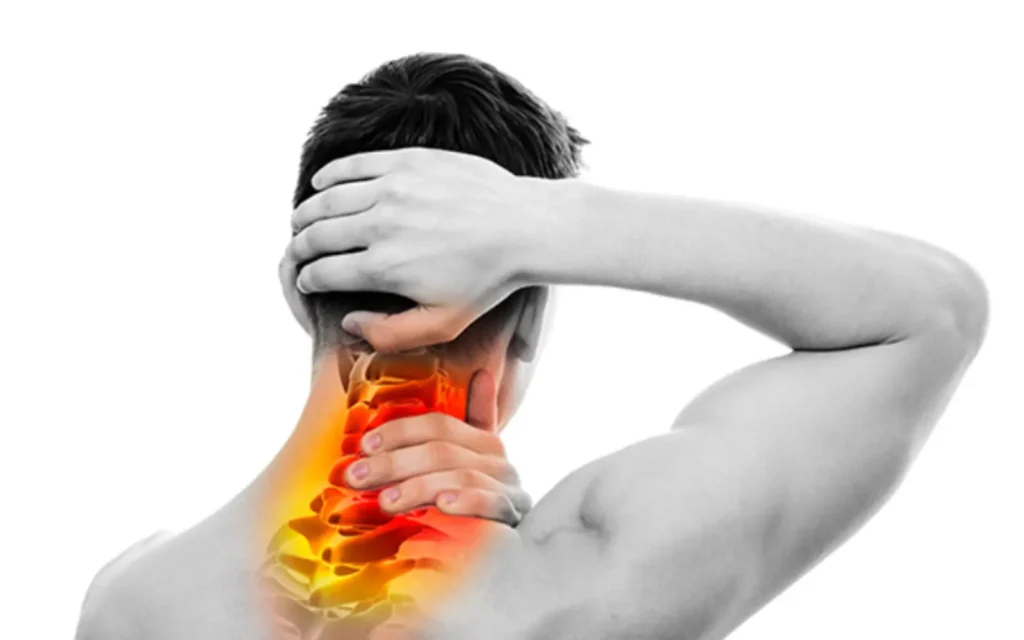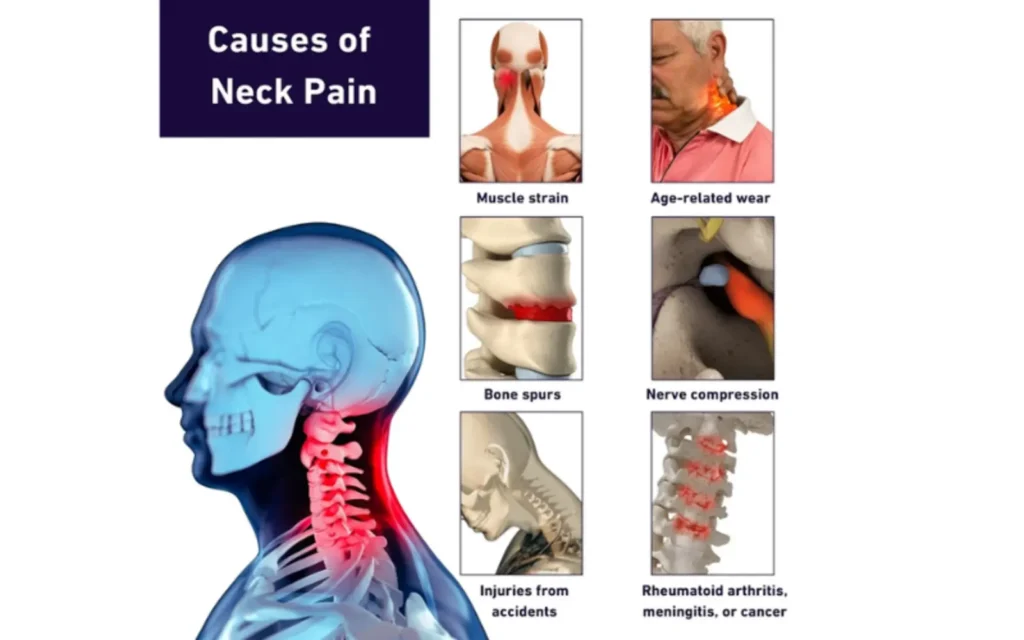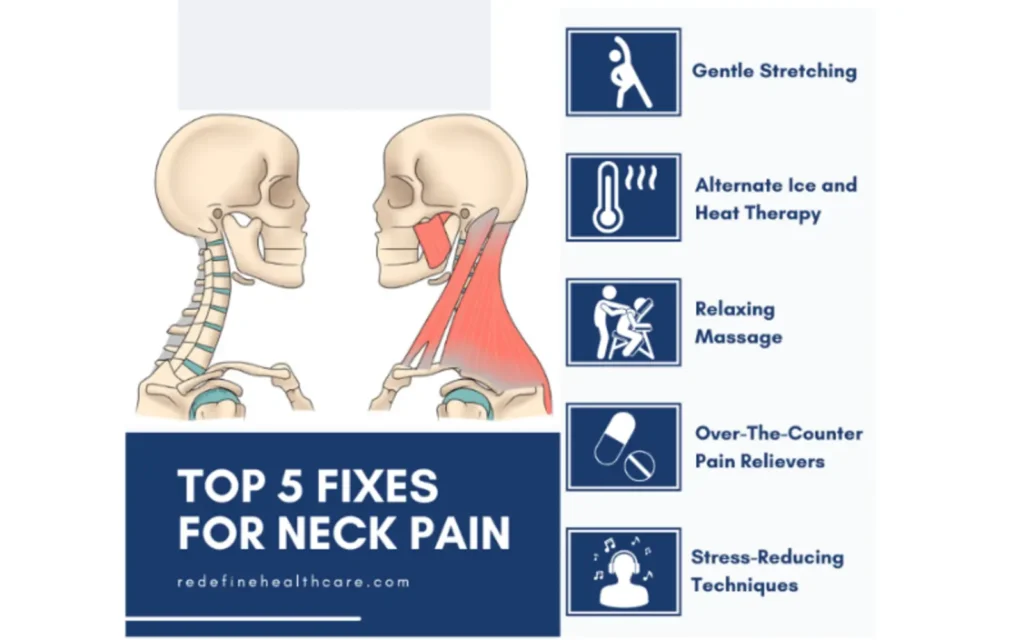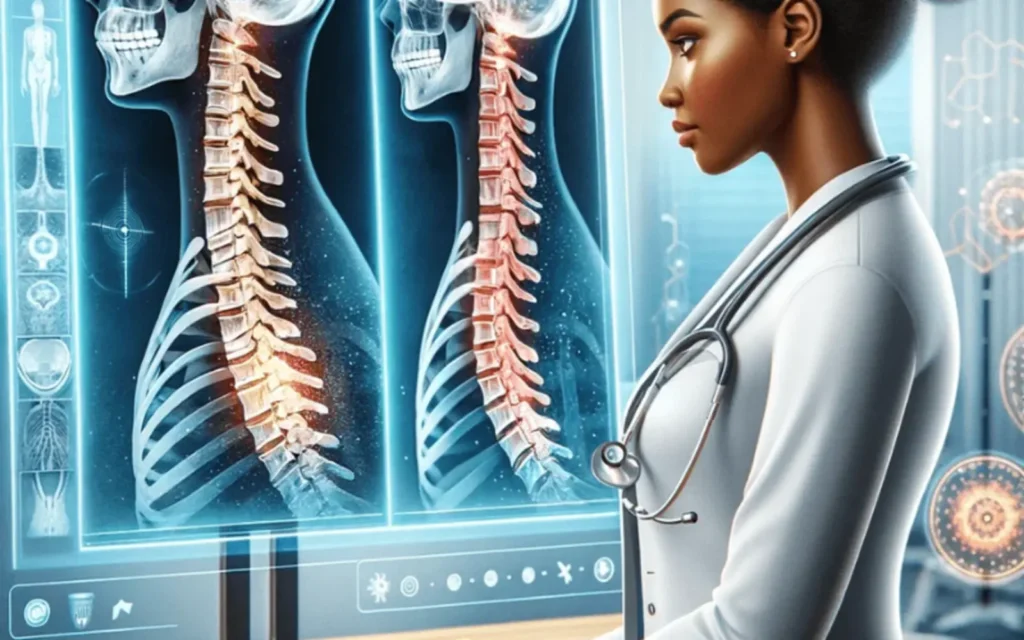Neck pain is common and affects many people daily. It can stem from various causes, some more obvious than others.
Understanding the reasons behind neck pain is vital. Whether it’s a sudden ache from sleeping wrong or a chronic issue from poor posture, knowing the cause can help you find the right solution. This blog will explore the top five reasons for neck pain.
We’ll discuss what might be causing your discomfort and how you can address it. You don’t have to live with neck pain. By identifying the root causes, you can take steps towards relief and better health. Let’s dive in and uncover what could be behind your neck pain.
Common Causes
Neck pain is a common issue that affects many people. Understanding the top reasons for neck pain can help you prevent and manage this discomfort. Here, we discuss the common causes of neck pain and how they impact our daily lives.
Poor Posture
Poor posture is a leading cause of neck pain. Many people spend long hours in front of computers, slouching or hunching over. This can strain the neck muscles and lead to pain.
Here are some common scenarios where poor posture can cause neck pain:
- Slouching at your desk
- Looking down at your phone for long periods
- Sleeping in an awkward position
Poor posture can cause the muscles and ligaments in your neck to work harder than they should. Over time, this can lead to stiffness and pain. To avoid this, try to maintain a neutral spine position, with your ears aligned with your shoulders.
Here is a simple table with tips to improve posture:
|
Activity |
Posture Tips |
|
Sitting at a desk |
Keep your back straight and feet flat on the floor |
|
Using a phone |
Hold the phone at eye level |
|
Sleeping |
Use a pillow that supports your neck |
Incorporating these habits into your daily routine can greatly reduce neck pain caused by poor posture.
Muscle Strain
Muscle strain is another common cause of neck pain. This can happen due to overuse or sudden movements that stretch the muscles beyond their limits.
Typical activities that can lead to muscle strain include:
- Carrying heavy bags
- Engaging in strenuous exercise without proper warm-up
- Sudden jerking movements, such as in sports or car accidents
When muscles are strained, they can become inflamed and sore. This can make it difficult to move your neck and may lead to stiffness.
To prevent muscle strain, consider the following tips:
- Warm up before physical activities
- Use proper techniques when lifting heavy objects
- Take breaks during repetitive activities
By following these guidelines, you can minimize the risk of muscle strain and keep your neck pain-free.
Injury Impact

Neck pain can disrupt daily life, making simple tasks difficult. One of the main causes of neck pain is injury. Various types of injuries can impact the neck, leading to pain and discomfort. Let’s explore the top reasons for neck pain due to injury impact.
Whiplash Effects
Whiplash is a common neck injury caused by a sudden jerking motion of the head. This often occurs in car accidents, but it can also happen during sports or falls. The rapid back-and-forth movement can strain the neck muscles and ligaments.
Here are some effects of whiplash:
- Neck pain and stiffness
- Headaches, often starting at the base of the skull
- Dizziness and fatigue
- Blurred vision
- Tinnitus (ringing in the ears)
Whiplash can also lead to more severe issues such as:
- Reduced range of motion
- Chronic pain
- Difficulty concentrating
- Memory problems
Recovery from whiplash varies. Some people recover within a few weeks, while others may experience symptoms for months or even years. Early treatment and proper care are essential for reducing long-term effects.
Sports Injuries
Sports injuries are another significant cause of neck pain. Athletes often push their bodies to the limit, leading to various types of injuries. Common neck injuries in sports include sprains, strains, and fractures.
Sports that commonly lead to neck injuries include:
- Football
- Wrestling
- Soccer
- Rugby
- Gymnastics
Here are some symptoms of neck injuries from sports:
- Sharp or dull pain in the neck
- Muscle spasms and tightness
- Swelling and bruising
- Limited neck movement
- Numbness or tingling in the arms
Proper warm-up exercises and using the right protective gear can help prevent these injuries. Immediate medical attention and following a rehabilitation program are crucial for a full recovery.
Age Factors
Neck pain is a common issue that affects many people. One of the significant factors contributing to neck pain is age. As we grow older, our bodies undergo various changes. These changes can lead to conditions that cause neck pain. Understanding these age-related factors can help in managing and preventing neck pain effectively.
Degenerative Disc Disease
Degenerative Disc Disease (DDD) is a common cause of neck pain in older adults. As we age, the discs in our spine lose hydration and elasticity. This process can lead to several issues:
- Disc Dehydration: Discs become less spongy and more brittle.
- Loss of Cushioning: Reduced ability to absorb shock.
- Increased Friction: Bones in the spine rub against each other.
These changes can cause pain and discomfort in the neck. Symptoms of DDD include:
- Chronic neck pain
- Stiffness
- Reduced range of motion
Managing DDD involves:
- Physical therapy to strengthen neck muscles
- Using anti-inflammatory medications
- Maintaining good posture
- Staying active with low-impact exercises
Arthritis
Arthritis is another age-related factor that can lead to neck pain. With age, the joints in the neck can become inflamed and stiff. There are several types of arthritis that can affect the neck:
- Osteoarthritis: Wear and tear of the joints.
- Rheumatoid Arthritis: An autoimmune condition causing joint inflammation.
Osteoarthritis in the neck can lead to:
- Bone spurs
- Swelling and stiffness
- Decreased flexibility
Managing arthritis involves:
- Regular exercise to maintain joint function
- Anti-inflammatory drugs to reduce pain and swelling
- Applying heat or cold packs
- Physical therapy to improve mobility
Understanding these age-related factors helps in taking proactive steps to manage neck pain. Early intervention and proper care can significantly improve quality of life.

Stress And Tension
Neck pain is a common issue that many people experience. One of the top reasons for neck pain is stress and tension. Stress can manifest in various ways, including emotional and physical symptoms, both of which can contribute to neck pain. Understanding how stress and tension affect your neck can help you find relief and prevent future discomfort.
Emotional Stress
Emotional stress often leads to neck pain. When you feel anxious or overwhelmed, your body reacts. This reaction can cause muscle tension, especially in the neck and shoulders. Here are some ways emotional stress impacts your neck:
- Muscle Tightening: Stress can cause muscles to contract. This tension can lead to pain and stiffness in your neck.
- Poor Posture: When stressed, people often hunch over or hold their heads in awkward positions. This can strain the neck muscles.
- Headaches: Stress-related headaches can cause pain that radiates from the head to the neck.
To manage emotional stress, consider these tips:
- Practice Relaxation Techniques: Activities like meditation, deep breathing, and yoga can help reduce stress levels.
- Stay Active: Regular exercise can improve mood and reduce tension.
- Seek Support: Talking to a friend or a professional can help you manage stress better.
Physical Tension
Physical tension is another major cause of neck pain. This type of tension often results from poor posture or repetitive motions. Here are some common sources of physical tension:
- Desk Jobs: Sitting at a desk for long periods can lead to neck strain. Poor ergonomics can worsen the problem.
- Sleeping Positions: Sleeping in awkward positions can cause neck pain. Using a supportive pillow can help.
- Repetitive Movements: Activities that involve repetitive neck movements, like using a phone or computer, can cause tension.
To alleviate physical tension in your neck, try these strategies:
- Adjust Your Workspace: Ensure your desk and chair are set up to support good posture. Keep your computer screen at eye level.
- Take Breaks: Stand up and stretch every hour to reduce muscle stiffness.
- Use Proper Pillows: Choose a pillow that keeps your neck in a neutral position while you sleep.
Sleeping Positions
Neck pain can be a real nuisance, impacting your daily activities and overall quality of life. One of the common causes of neck pain is your sleeping position. The way you sleep plays a crucial role in either alleviating or exacerbating neck pain. Let’s explore the top reasons related to sleeping positions that might be causing your neck discomfort.
Bad Pillow Choices
Choosing the right pillow is essential for neck health. A bad pillow can cause your neck to bend unnaturally, leading to pain and stiffness. Here are some key points to consider:
- Height: A pillow that is too high or too low can misalign your neck.
- Material: Memory foam, latex, and feather pillows offer different levels of support.
- Firmness: A pillow that is too soft or too firm might not provide adequate support.
Here’s a table to help you choose the right pillow based on your sleeping position:
|
Sleeping Position |
Recommended Pillow Type |
|
Back Sleeper |
Medium-firm pillow |
|
Side Sleeper |
Firm and thick pillow |
|
Stomach Sleeper |
Thin and soft pillow |
Always choose a pillow that keeps your neck aligned with your spine. This will help prevent neck pain and improve sleep quality. Replace your pillow every 1-2 years to ensure it continues to provide the right support.
Wrong Mattress Type
The type of mattress you sleep on can also contribute to neck pain. A mattress that does not provide proper support can cause your body to sink, leading to misalignment of the spine and neck. Consider the following factors:
- Firmness: A mattress that is too soft or too firm can cause discomfort.
- Material: Memory foam and latex mattresses often offer better support.
- Age: An old mattress may lose its supportive qualities over time.
Here’s a guide to help you choose the right mattress based on your sleeping position:
|
Sleeping Position |
Recommended Mattress Type |
|
Back Sleeper |
Medium-firm mattress |
|
Side Sleeper |
Slightly softer mattress |
|
Stomach Sleeper |
Firm mattress |
Always replace your mattress every 7-10 years. This ensures you get the right support and comfort, reducing the risk of neck pain. Investing in a good mattress can make a significant difference in your overall health and well-being.

Repetitive Movements
Neck pain is a common problem that affects people of all ages. One of the leading causes is repetitive movements. These are actions you perform over and over again, which can strain the muscles and ligaments in your neck. Over time, this can lead to discomfort and pain. Understanding how repetitive movements contribute to neck pain can help you take steps to prevent it.
Workplace Habits
Many people experience neck pain due to poor workplace habits. Spending long hours at a desk or computer can lead to repetitive strain on the neck muscles. Here are some common causes:
- Poor Posture: Slouching or leaning forward to look at a screen.
- Prolonged Sitting: Sitting for extended periods without breaks.
- Improper Desk Setup: Monitor height and chair position not optimized.
To reduce neck pain caused by workplace habits, consider the following tips:
- Adjust your chair and monitor to keep your head level.
- Take frequent breaks to stand up and stretch.
- Use a headset if you talk on the phone frequently.
- Practice good posture by keeping your shoulders relaxed and your back straight.
Implementing these changes can significantly reduce the strain on your neck.
Sports Activities
Sports activities can also lead to repetitive neck movements. Athletes are often at risk due to the nature of their training and performance. Here are some examples:
- Swimming: Repeated neck rotation during strokes.
- Cycling: Maintaining a forward head position for long periods.
- Running: The impact of foot striking can travel up to the neck.
Athletes can take steps to prevent neck pain:
- Incorporate neck stretching and strengthening exercises into your routine.
- Ensure proper form and technique during activities.
- Use appropriate gear, such as supportive shoes for running.
- Stay hydrated and maintain overall muscle health.
By being mindful of your movements and taking preventive measures, you can protect your neck from pain related to sports activities.
Health Conditions
Neck pain is a common complaint that affects many people at some point in their lives. Various factors contribute to neck pain, and understanding them can help in managing and preventing discomfort. One significant category of causes is health conditions. These conditions can lead to chronic neck pain and require medical attention for proper diagnosis and treatment.
Fibromyalgia
Fibromyalgia is a chronic disorder characterized by widespread pain, including in the neck. This condition affects the way the brain processes pain signals, making pain sensations more intense. People with fibromyalgia often experience neck pain along with other symptoms such as:
- Fatigue
- Sleep disturbances
- Memory issues
- Mood swings
The exact cause of fibromyalgia is unknown, but it is believed to involve a combination of genetic, environmental, and psychological factors. Individuals with fibromyalgia may have a heightened sensitivity to pain due to abnormal levels of certain chemicals in the brain that signal pain.
Treatment for fibromyalgia-related neck pain typically involves a multidisciplinary approach, including:
- Medications such as pain relievers and antidepressants
- Physical therapy to improve strength and flexibility
- Cognitive-behavioral therapy to manage stress and improve coping skills
- Regular exercise to reduce pain and improve overall well-being
Living with fibromyalgia requires ongoing management and lifestyle adjustments to minimize pain and improve quality of life.
Cervical Spondylosis
Cervical spondylosis, also known as neck arthritis, is a common age-related condition. It involves the degeneration of the cervical spine, including the discs and joints in the neck. This degeneration can lead to neck pain and stiffness. Common symptoms of cervical spondylosis include:
- Chronic neck pain
- Stiffness in the neck
- Headaches, often starting from the neck
- Numbness or tingling in the arms or hands
- Weakness in the arms or legs
Factors that contribute to cervical spondylosis include:
|
Factor |
Description |
|
Aging |
Wear and tear of the cervical spine over time |
|
Herniated discs |
Discs can develop cracks, leading to bulging or rupture |
|
Bone spurs |
Overgrowth of bone that can press on spinal nerves |
|
Dehydrated discs |
Loss of fluid in the discs, reducing their cushioning ability |
Treatment options for cervical spondylosis include:
- Medications such as nonsteroidal anti-inflammatory drugs (NSAIDs) and muscle relaxants
- Physical therapy to strengthen neck muscles and improve posture
- Hot or cold compresses to reduce pain and inflammation
- In severe cases, surgical intervention may be necessary to relieve nerve compression
Early diagnosis and proper management can help alleviate symptoms and improve the quality of life for those with cervical spondylosis.

Tech Usage
Neck pain is a common issue that many people face today. One of the top reasons for neck pain is tech usage. With the rise of smartphones and computers, many individuals spend long hours looking at screens. This can lead to various neck problems. Let’s explore the specific causes related to tech usage.
Smartphone Neck
Smartphone neck, also known as “text neck,” occurs when you spend too much time looking down at your phone. This position can strain your neck muscles and lead to pain. The more you tilt your head forward, the more pressure you put on your neck.
- Frequent Use: Constantly checking your phone can cause repetitive strain on your neck.
- Improper Posture: Holding your phone at a low angle forces you to bend your neck.
- Extended Duration: Long sessions of using your phone without breaks can worsen the pain.
To avoid smartphone neck, try to keep your phone at eye level. Take regular breaks to stretch and move your neck. Using voice commands instead of typing can also reduce the strain on your neck.
|
Factors |
Impact on Neck |
|
Head Tilt |
Increases pressure on neck |
|
Screen Time |
Leads to muscle fatigue |
|
Poor Posture |
Causes neck strain |
Computer Ergonomics
Many people work on computers for hours each day. Poor ergonomics can lead to neck pain. The way you set up your workstation can make a big difference.
- Monitor Height: If your monitor is too low or too high, you might strain your neck.
- Keyboard Placement: A keyboard that is too far away can cause you to lean forward, putting stress on your neck.
- Chair Support: Without proper back support, you may end up slouching, leading to neck pain.
To improve computer ergonomics, ensure your monitor is at eye level. Keep your keyboard and mouse within easy reach. Use a chair that supports your lower back. Taking short breaks to stretch can also help reduce neck pain.
|
Ergonomic Factors |
Solutions |
|
Monitor Position |
Adjust to eye level |
|
Keyboard Distance |
Keep within reach |
|
Chair Support |
Use ergonomic chairs |
Preventive Measures
Neck pain is a common complaint that affects many people. It can stem from various causes such as poor posture, stress, injury, or even sleeping positions. Implementing preventive measures can help reduce the risk of neck pain and improve overall neck health. Here, we discuss some effective preventive measures to keep neck pain at bay.
Stretching Exercises
Regular stretching can keep the neck muscles flexible and strong. It can help prevent stiffness and reduce the chances of developing neck pain. Here are some simple stretching exercises to incorporate into your daily routine:
- Neck Tilts: Sit or stand with your back straight. Slowly tilt your head toward your shoulder. Hold for 15 seconds. Repeat on the other side.
- Side-to-Side Head Rotation: Turn your head to the right and hold for 15 seconds. Then, turn your head to the left and hold for 15 seconds.
- Chin Tucks: Sit or stand with your back straight. Gently tuck your chin towards your chest. Hold for 5 seconds and release.
- Shoulder Rolls: Roll your shoulders forward in a circular motion for 10 repetitions. Then, roll them backward for 10 repetitions.
Perform these stretches at least twice a day. Consistency is key to preventing neck pain. Stretching improves blood flow to the muscles, which can aid in healing and prevention.
Posture Correction
Maintaining proper posture is crucial for preventing neck pain. Poor posture puts extra strain on the neck muscles and can lead to chronic discomfort. Here are some tips for improving posture:
- Keep your monitor at eye level: Adjust your computer screen so that it is at eye level. This prevents you from bending your neck forward.
- Use a supportive chair: Sit in a chair that supports your lower back. Keep your feet flat on the floor and your knees at a right angle.
- Hold your phone at eye level: Avoid looking down at your phone. Hold it up to eye level to reduce neck strain.
- Avoid slouching: Sit and stand with your shoulders back. Keep your back straight and avoid slouching.
Proper posture can reduce the risk of neck pain significantly. It helps distribute your body weight evenly and reduces strain on your neck muscles. Regularly check your posture throughout the day to ensure you are maintaining good habits.
When To Seek Help
Experiencing neck pain can be bothersome and affect daily activities. Identifying the top 5 reasons for neck pain can help you understand the underlying causes. But knowing when to seek help is crucial for proper management and recovery. Here, we discuss the signs that indicate serious issues and the importance of consulting professionals.
Signs Of Serious Issues
Neck pain can sometimes signal serious health problems. Recognizing these signs early is vital to prevent further complications. Here are some symptoms that require immediate attention:
- Severe pain: Intense and persistent pain that does not improve with rest or over-the-counter medications.
- Numbness or tingling: Sensations of numbness, tingling, or weakness in your arms or hands.
- Loss of coordination: Difficulty walking or maintaining balance.
- Bladder or bowel dysfunction: Inability to control bladder or bowel movements.
- Fever and chills: Accompanied by unexplained weight loss.
If you experience any of these symptoms, it’s essential to seek medical help. Delaying treatment can lead to more severe health issues. Below is a table summarizing the signs to watch for:
|
Symptom |
Description |
|
Severe pain |
Intense, persistent pain |
|
Numbness or tingling |
Sensations in arms or hands |
|
Loss of coordination |
Difficulty walking or balancing |
|
Bladder or bowel dysfunction |
Inability to control functions |
|
Fever and chills |
Accompanied by weight loss |
Consulting Professionals
Consulting a healthcare professional is crucial when dealing with neck pain. They can diagnose the underlying cause and recommend appropriate treatment. Here are some steps to consider when seeking help:
- Visit your primary care doctor: They will perform an initial assessment and may refer you to a specialist.
- See a specialist: Orthopedic doctors, neurologists, or rheumatologists can provide targeted care.
- Physical therapy: A physical therapist can design exercises to strengthen neck muscles and improve flexibility.
- Chiropractor consultation: Chiropractors offer spinal adjustments and other treatments for neck pain.
- Alternative therapies: Consider acupuncture, massage therapy, or yoga for additional relief.
Each professional brings unique expertise to manage neck pain effectively. Below is a brief description of what each specialist offers:
|
Professional |
Role |
|
Primary Care Doctor |
Initial assessment, referrals |
|
Specialists (Orthopedic, Neurologist, Rheumatologist) |
Targeted diagnosis and treatment |
|
Physical Therapist |
Exercise and flexibility programs |
|
Chiropractor |
Spinal adjustments, treatments |
|
Alternative Therapists |
Acupuncture, massage, yoga |
Early consultation with professionals can lead to better outcomes. Don’t ignore the signs and seek help when needed.
Frequently Asked Questions
What Are Common Causes Of Neck Pain?
Poor posture, muscle strain, and injuries are common causes of neck pain.
Can Stress Lead To Neck Pain?
Yes, stress can cause muscle tension, leading to neck pain.
How Can Sleeping Position Affect Neck Pain?
Sleeping on your stomach or with a poor pillow can worsen neck pain.
Is Neck Pain Related To Technology Use?
Yes, prolonged use of phones or computers can cause neck strain.

Conclusion
Neck pain affects many people. Poor posture is a common cause. Stress and tension also contribute. Injuries can lead to neck pain too. Poor sleeping positions often hurt the neck. Lastly, medical conditions may be the reason. Understanding these causes helps manage and prevent neck pain.
Simple changes can bring relief. Always seek medical advice for severe pain. Stay mindful of your neck health.

